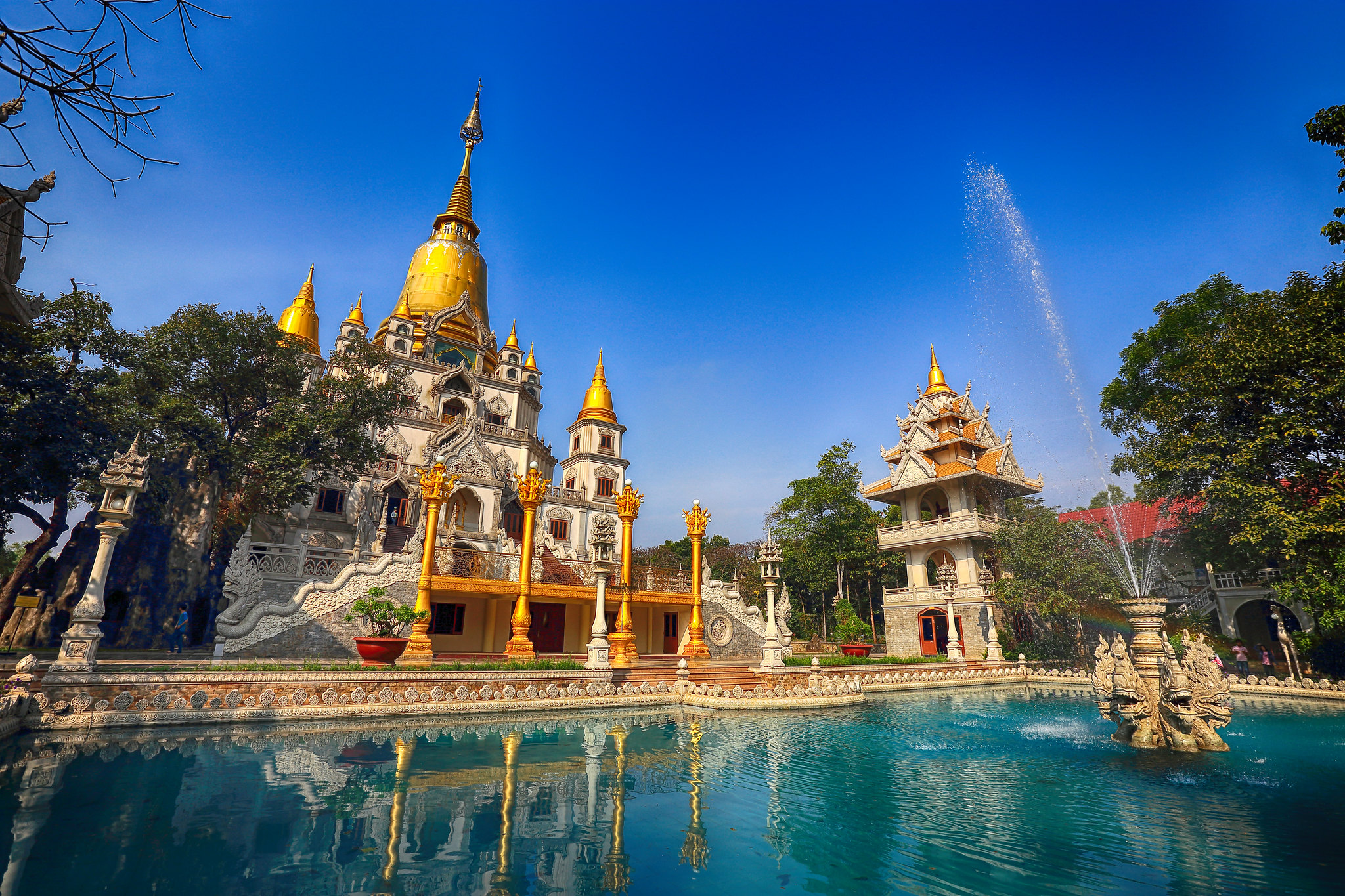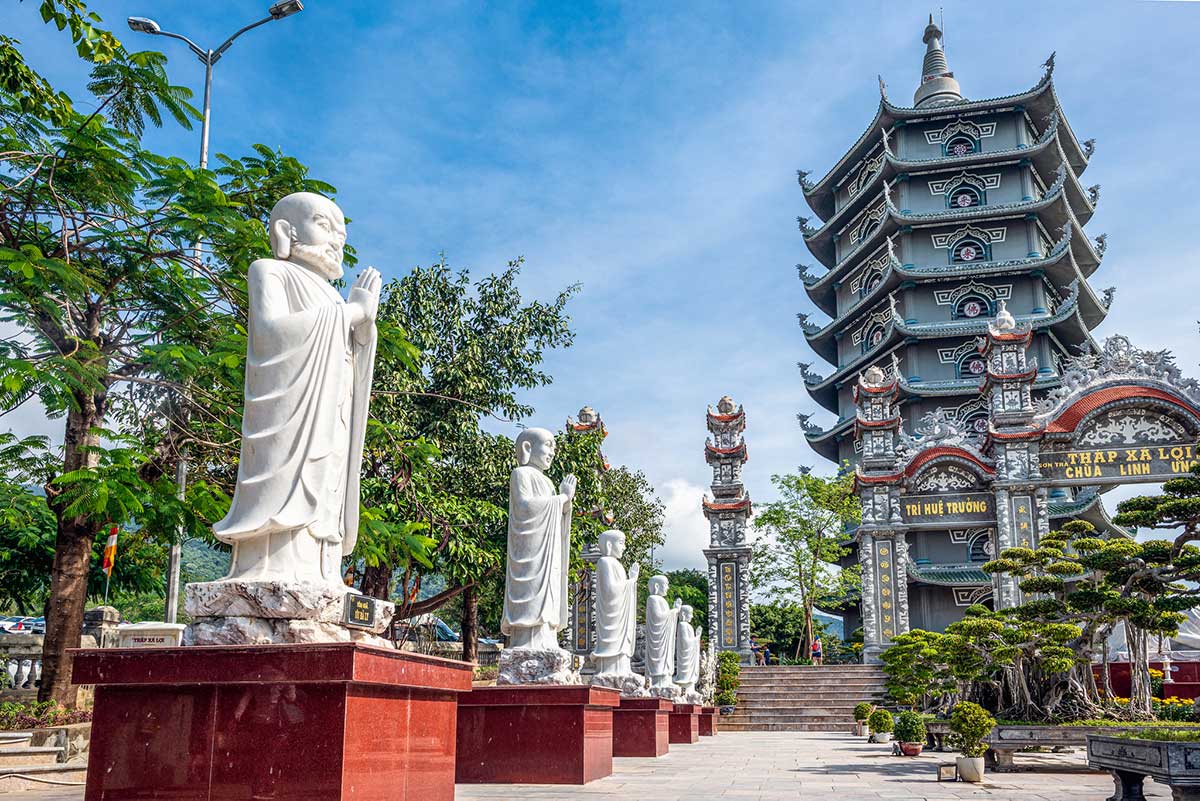Top Temples in Vietnam: A Journey Through the Country’s Sacred Heritage
Vietnam is a country rich in history, culture, and spirituality, with a deep connection to Buddhism and ancient traditions. As you explore the diverse landscapes and vibrant cities, you’ll also encounter some of the most magnificent temples in the world. These sacred sites are not just places of worship, but also monuments that tell the story of Vietnam’s spiritual journey.
In this article, we will take you on a tour of the top temples in Vietnam, showcasing their unique history, architectural beauty, and cultural significance.

1. Buu Long Pagoda: A Tranquil Escape in Dong Nai
Nestled in the province of Dong Nai, just outside of Ho Chi Minh City, Buu Long Pagoda is often referred to as the “Miniature Laos”. It boasts a stunning architectural style that blends Vietnamese and Thai influences, featuring golden roofs, large statues, and serene lotus ponds. The pagoda is set amidst lush greenery, making it the perfect escape for those seeking peace and spiritual solace.
Visitors come to Buu Long Pagoda not only for its tranquil atmosphere but also to enjoy the panoramic view of the surrounding area. It’s a popular spot for locals who come to pray, meditate, and connect with nature.
Highlights:
-
Buddha statues in various postures
-
Lush gardens and lotus ponds
-
Stunning golden architecture influenced by Thai design
Learn more about Vietnam’s temple culture here.

2. Linh Ung Pagoda: A Magnificent Symbol of Spirituality in Da Nang
Situated on the picturesque Son Tra Peninsula in Da Nang, the Linh Ung Pagoda is one of the most famous temples in Vietnam. The highlight of the pagoda is its towering Lady Buddha statue, standing at 67 meters, making it the tallest statue of the Buddha in Vietnam. The statue gazes out towards the sea, offering protection and blessings to the people of Da Nang.
The Linh Ung Pagoda is not just an architectural marvel; it also offers breathtaking views of the coastline and city. Visitors often come here to pay their respects, enjoy the natural beauty, and take in the peaceful surroundings.
Why visit Linh Ung Pagoda?
-
Impressive Lady Buddha statue (67 meters tall)
-
Spectacular views of the coastline and Da Nang city
-
A spiritual sanctuary with peaceful gardens

3. Temple of Literature: A Center for Learning and Culture in Hanoi
The Temple of Literature in Hanoi is one of the oldest and most significant temples in Vietnam. Established in 1070, it is dedicated to Confucius and is known as the country’s first university. The temple complex is a serene place, with traditional Vietnamese architecture, beautiful courtyards, and stone stelae inscribed with the names of successful scholars.
Visitors can explore the Temple of Literature’s various halls and pavilions, each with its own significance in the realm of Vietnamese learning and education. The temple stands as a symbol of respect for knowledge and academic achievement.
Key Features:
-
Confucian-inspired architecture
-
Historical significance as Vietnam’s first university
-
Scholar’s stelae, marking the achievements of past scholars

4. One Pillar Pagoda: A Symbol of Hanoi’s Rich Heritage
The One Pillar Pagoda is one of Hanoi’s most iconic landmarks. This unique temple is built on a single stone pillar, making it one of the most unusual and memorable architectural structures in Vietnam. It was first constructed in 1049 under the reign of Emperor Ly Thai Tong and has since become a symbol of the country’s heritage.
Legend has it that the emperor built the pagoda after dreaming of a lotus flower. The pagoda is small but features intricate carvings and a serene atmosphere, making it a must-visit spot for anyone exploring Hanoi.
Key Features:
-
Unique design with a single pillar
-
Rich historical significance tied to Vietnam’s ancient emperors
-
A serene atmosphere perfect for reflection
Discover more about Hanoi’s historical landmarks.
5. Tran Quoc Pagoda: The Oldest Pagoda in Hanoi
Located on West Lake in Hanoi, Tran Quoc Pagoda is the oldest pagoda in the city, with a history dating back over 1,500 years. This stunning temple is dedicated to Buddha and features a unique blend of ancient architecture and peaceful natural surroundings. The pagoda is home to several relics, including ancient Buddhist statues and scriptures.
The tranquil environment of Tran Quoc Pagoda is perfect for meditation, and the stunning views of West Lake add to the temple’s allure. Visitors come here to experience the peaceful serenity of the area while learning about Vietnam’s ancient spiritual traditions.
Highlights:
-
Over 1,500 years of history
-
Buddhist relics and ancient scriptures
-
Scenic views of West Lake

6. Ba Na Hills Pagoda: A Unique Experience on Top of the Mountain
Ba Na Hills Pagoda is not just a religious site but also a modern marvel located on top of the Ba Na Hills mountain, near Da Nang. Visitors can reach the pagoda via the famous Golden Bridge, which is supported by giant stone hands. The pagoda houses a large Buddha statue and offers spectacular views of the surrounding landscape.
The high-altitude location and the innovative design of the Golden Bridge make Ba Na Hills Pagoda a one-of-a-kind experience, combining natural beauty, religious significance, and modern architecture.
Features:
-
Golden Bridge with stone hands
-
Large Buddha statue and serene ambiance
-
Panoramic views from the mountaintop
Conclusion: A Spiritual Journey Through Vietnam’s Temples
Vietnam’s temples are more than just places of worship—they are windows into the country’s rich spiritual and cultural heritage. Each temple offers a unique experience, from the towering statues of Linh Ung Pagoda to the tranquil surroundings of Buu Long Pagoda. Visiting these sacred sites is a journey of reflection, learning, and connection with Vietnam’s past.
Whether you are seeking peace, adventure, or insight into Vietnam’s history, these top temples provide something for every traveler.
FAQs About Vietnam’s Temples
1. What is the significance of Vietnam’s temples?
Vietnam’s temples are important cultural and religious sites. They serve as places of worship, reflection, and learning, and many are centuries-old, showcasing the country’s historical and spiritual development.
2. Can I visit these temples as a tourist?
Yes, most of these temples are open to tourists. However, visitors are encouraged to show respect for the spiritual traditions and follow the local customs.
3. What should I wear when visiting temples in Vietnam?
It is important to dress modestly when visiting temples. This means covering your shoulders and knees, and removing your shoes before entering sacred areas.
4. How do I get to Ba Na Hills Pagoda?
You can reach Ba Na Hills Pagoda by taking the Ba Na cable car from Da Nang, which offers a stunning view of the surrounding landscape.
These temples are not just architectural wonders; they are living symbols of Vietnam’s enduring spiritual legacy. When you visit them, you’re not only exploring history, but you’re also stepping into a sacred space that has shaped the identity of Vietnam for centuries.




